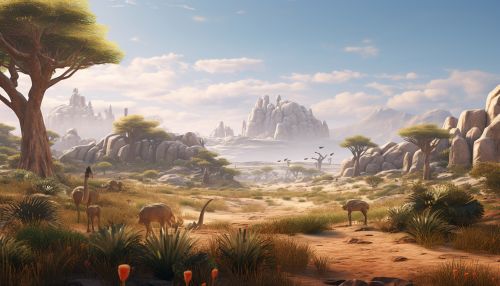Desert Adaptation
Introduction
Desert adaptation refers to the physiological, behavioral, and morphological changes that organisms undergo to survive in the harsh conditions of deserts. These adaptations are a result of the extreme environmental conditions such as high temperatures, low humidity, and scarce water resources. Desert-adapted organisms have developed unique strategies to cope with these challenges, making them some of the most resilient life forms on the planet.


Physiological Adaptations
Physiological adaptations are internal bodily functions that help an organism survive in its environment. In deserts, these adaptations often involve water conservation and temperature regulation.
Water Conservation
Desert organisms have evolved various mechanisms to conserve water. For instance, many desert plants, such as cacti, have thick, waxy cuticles that reduce water loss through transpiration. They also have shallow but extensive root systems that can quickly absorb any available water.
Desert animals also exhibit water conservation strategies. Many, like the kangaroo rat, produce highly concentrated urine to minimize water loss. Some desert animals, such as the dromedary camel, can tolerate high body temperatures, reducing the need for evaporative cooling and thus conserving water.
Temperature Regulation
Temperature regulation is another crucial physiological adaptation in desert organisms. Many desert animals are nocturnal, active during the cooler night hours to avoid the intense daytime heat. Some desert plants, like the saguaro cactus, can store water in their tissues, which helps to regulate their internal temperature.
Behavioral Adaptations
Behavioral adaptations are actions organisms take to survive in their environment. In the desert, these behaviors often involve seeking shelter from the harsh conditions and modifying activity patterns.
Shelter Seeking
Many desert animals burrow underground to escape the extreme temperatures and conserve water. For example, the fennec fox digs deep burrows where it can rest during the day, protected from the heat.
Desert plants also exhibit shelter-seeking behaviors. Some, like the creosote bush, grow in a way that their own branches provide shade for the base of the plant, reducing water loss from the soil.
Activity Modification
Activity modification is another common behavioral adaptation in desert organisms. Many desert animals are crepuscular, meaning they are most active during the twilight hours of dawn and dusk when temperatures are more moderate. Some desert plants, like the evening primrose, only open their flowers at night to conserve water and attract nocturnal pollinators.
Morphological Adaptations
Morphological adaptations are physical characteristics that help an organism survive in its environment. In the desert, these adaptations often involve specialized structures for water storage and heat resistance.
Water Storage
Many desert plants have developed structures for storing water. Cacti, for instance, have thick, fleshy stems that can store large amounts of water. Some desert animals, like the dromedary camel, store fat in their humps, which can be metabolized to produce water when needed.
Heat Resistance
Heat resistance is another common morphological adaptation in desert organisms. Many desert animals have light-colored fur or feathers, which reflect sunlight and help keep them cool. Some desert plants, like the Joshua tree, have tough, leathery leaves that can withstand the intense desert sun.
Conclusion
Desert adaptation is a fascinating example of how life can thrive in even the most inhospitable environments. Through a combination of physiological, behavioral, and morphological adaptations, desert organisms have found ways to conserve water, regulate temperature, and survive in the harsh desert conditions. These adaptations highlight the incredible resilience and diversity of life on Earth.
